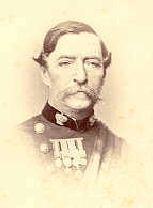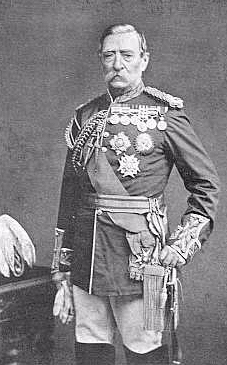
FIELD-MARSHAL
LORD NAPIER OF MAGDALA
AND CARYINGTON, G.C.B., G.C.S.I.
The cdv image of Lord Napier is circa 1860 when he was a Lieutenant Colonel. The miniature medals he is wearing include the Sutlej Campaign Medal [MOODKEE][SOBRAON], the Punjab Campaign Medal [MOOLTAN][GOOJERAT], the Indian Mutiny Medal [RELIEF OF LUCKNOW][LUCKNOW][CENTRAL INDIA], and the Second China War Medal [TAKU FORTS 1860][PEKIN 1860]. He is also wearing two orders: the C.B. and the C.S.I.
The photograph was taken by John Watkins of 34, Parliament
Street London.
The following is an outline of the key events in the life and military career of Lord Napier:
1810 Dec 06: Born in Ceylon; Robert Cornelis Napier, son of Major C.F. Napier, R.A.
1825 Feb 04: To Addiscombe.
1826 Dec 15: Commissioned 2nd Lieutenant, Royal Engineers.
1827 Sep 28: Promoted First Lieutenant. Assigned for training to the Royal Engineer Establishment at Chatham.
1828 Nov To India.
1831 Apr 21: Appointed Assistant Engineer on the Doab Canal and later on the Great Eastern Jumna Canal.
1836: Returned to England to inspect various public works projects.
1838: Posted to Darjeeling, India.
1840 Sep 30: Promoted Captain.
1842: Appointed Executive Engineer of the Sirhind Division.
1845 - 1846: Sutlej Campaign.
1845 Dec: Service in the First Sikh War. Present at the Battle of Moodkee and Ferozeshah as Chief Engineer.
Severely wounded. Brigade Major of Engineers at the Battle of Sobraon. Served in the advance on Lahore.
Mentioned in despatches and promoted to a brevet majority.
1846 Apr 03: Promoted Major (Army Rank).
1846 May: Served as Chief Engineer for the reduction of the fortress at Kote Kangra.
1848 - 1849: Punjab Campaign.
Served in the Second Sikh War. Chief Engineer at the siege of Mooltan. Wounded and disabled for some weeks. Present at the Battle of Gujerat as C.R.E. right wing. Received the brevet rank of Lieutenant Colonel.
Appointed Civil Engineer for the Punjab.
1849 Jun 07: Promoted Lieutenant Colonel (Army Rank)
1852 Dec: Hazara Campaign.
Served with the Black Mountain Expedition.
1853 Nov: North West Frontier.
Took part in the expedition against the Jowaki Afridis in the Bori Valley.
1854 Aug 01: Promoted Major (Regimental Rank).
1854 Nov 28: Promoted Colonel (Army Rank).
1856: Home to England on leave.
1856 Apr 15: Promoted Lieutenant Colonel (Regimental Rank).
1857 - 1859: Indian Mutiny.
1857 Nov 17: Severely wounded at the Relief of Lucknow. Awarded the C.B.
1858 Jan: Rejoined Sir James Outram’s staff from hospital. Stationed at Alumbagh.
1858 Jun: Took command of the 2nd Brigade in Sir Hugh Rose’s division at Bahadurpore.
Appointed Brigadier General.
1860 China War.
1860 Jan: Took command of the Second Division in the China Expeditionary Force.
1860 Apr: Arrived in Hong Kong.
1860 Aug: Landed in China.
Returned to India after the China War.
1861 Feb 15: Promoted Major General (Army Rank).
1861 Feb 18: Promoted Colonel (Regimental Rank).
1865 Appointed Commander-in-Chief of the Bombay Army.
1867 Mar 01: Promoted Lieutenant General (Army Rank).
1867 - 1868: Abyssinian Campaign.
1867 Aug 13: Appointed to command the Abyssinian Expedition.
1868 Jan 05: Disembarked at Annesley Bay in Abyssinia.
Returned to India on the close of the campaign. Raised to the peerage as Baron Napier of Magdala and awarded the G.C.B.
1870: Appointed Commander-in-Chief, India.
1874 Apr 01: Promoted General (Army Rank) and appointed Colonel Commandant of the Royal Engineers.
1876: Returned home to England.
Appointed Governor of Gibraltar.
1883 Jan 01: Promoted Field Marshal.
1887: Returned home to England.
1888 Jul: Awarded the G.C.S.I.
1890 Jan 14: Died in London of influenza at age 80. Buried in St. Paul’s Cathedral.
Lord Napier was married, first to Anne Sarah, daughter of George Pease, M.D., E.I.C.S., and secondly, in 1861, to Mary Cecilia, daughter of Major General E.S. Scott, R.A. He was succeeded in the peerage after his death by his eldest son, Robert William, formerly Lieutenant Colonel, Bengal Staff Corps.
REFERENCES:
1. CONOLLY, T.W.J. Roll of Officers of the Corps of Royal Engineers From 1660 to 1898. The Royal Engineers Institute, Chatham, Kent, 1898.
2. THACKERAY, E.T. Biographical Notices of Officers of the Royal (Bengal) Engineers. Smith, Elder & Co., London. 1900.